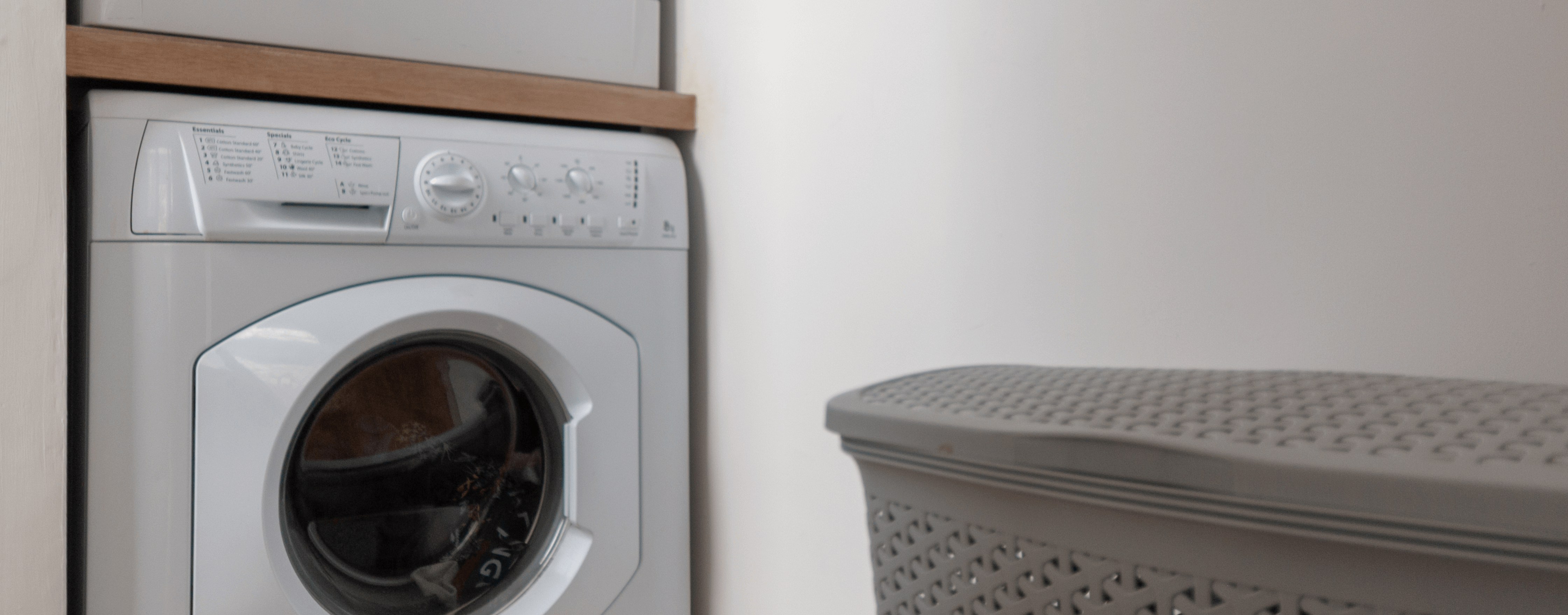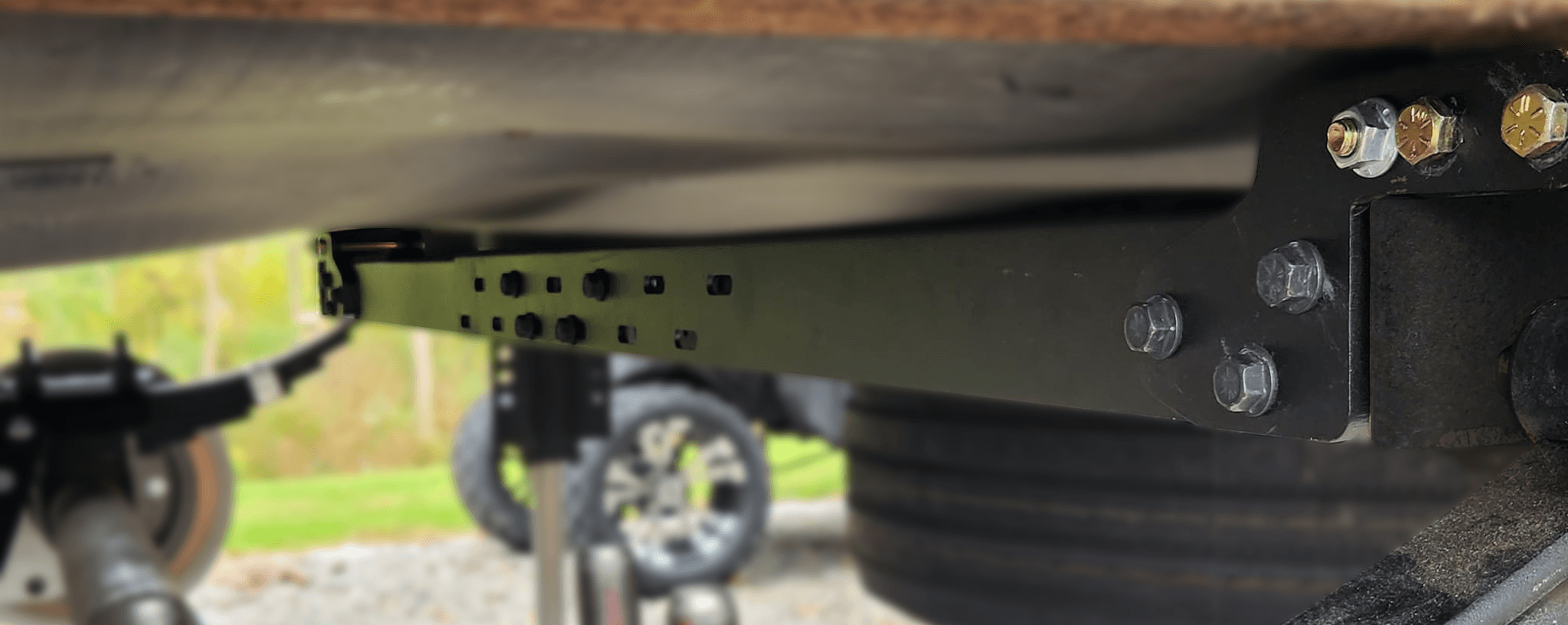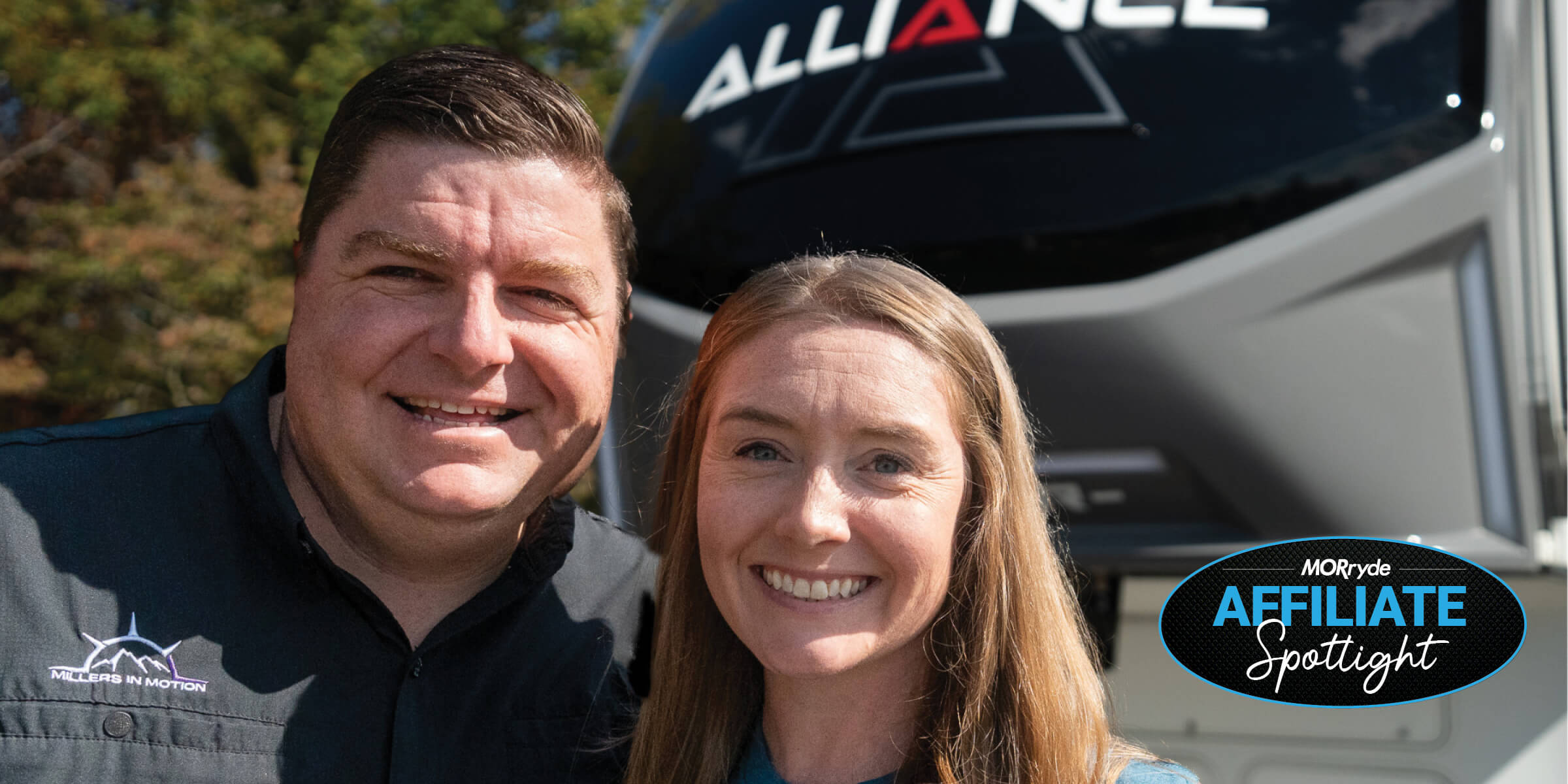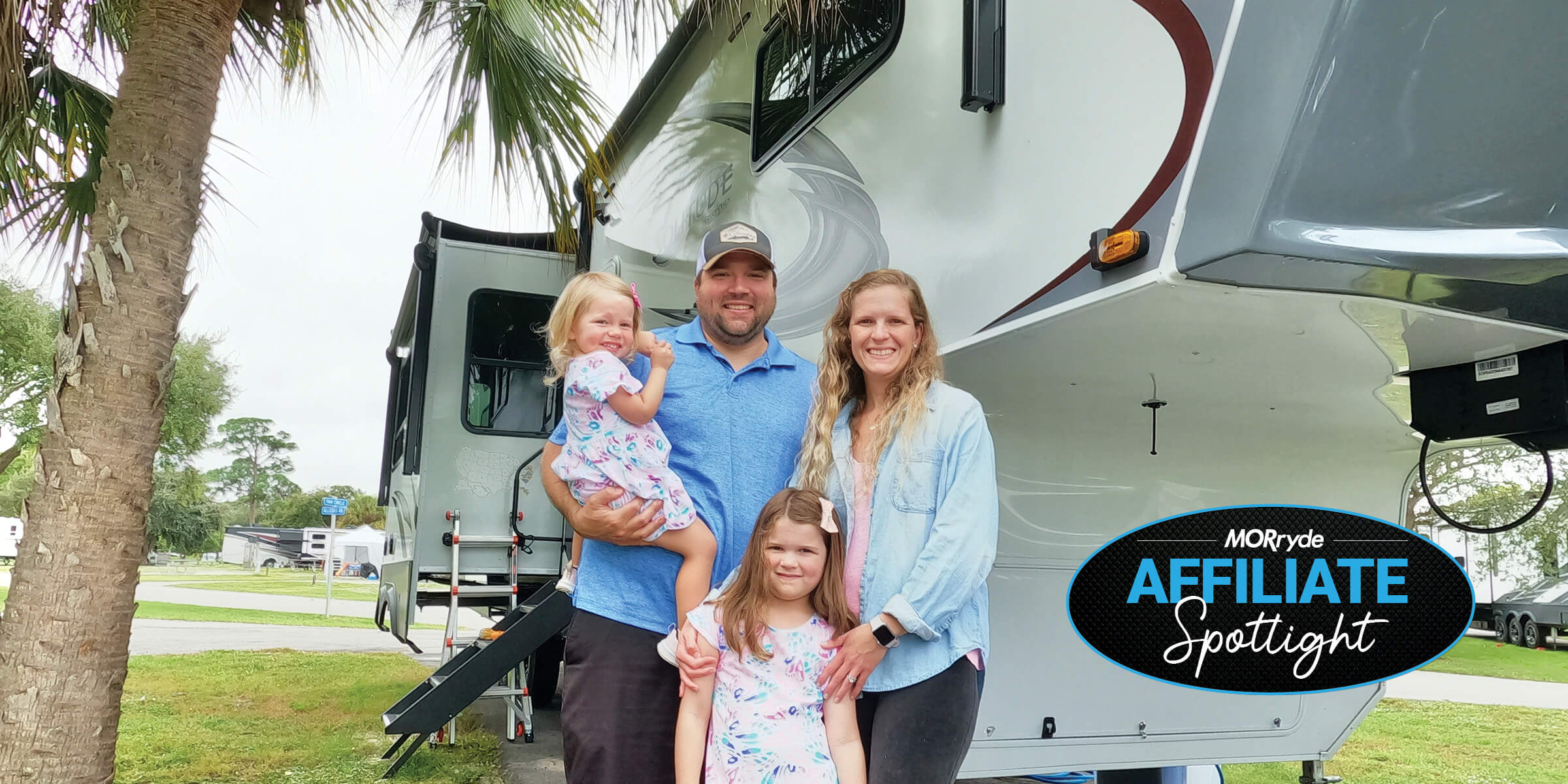Product News: Sign up for new product updates
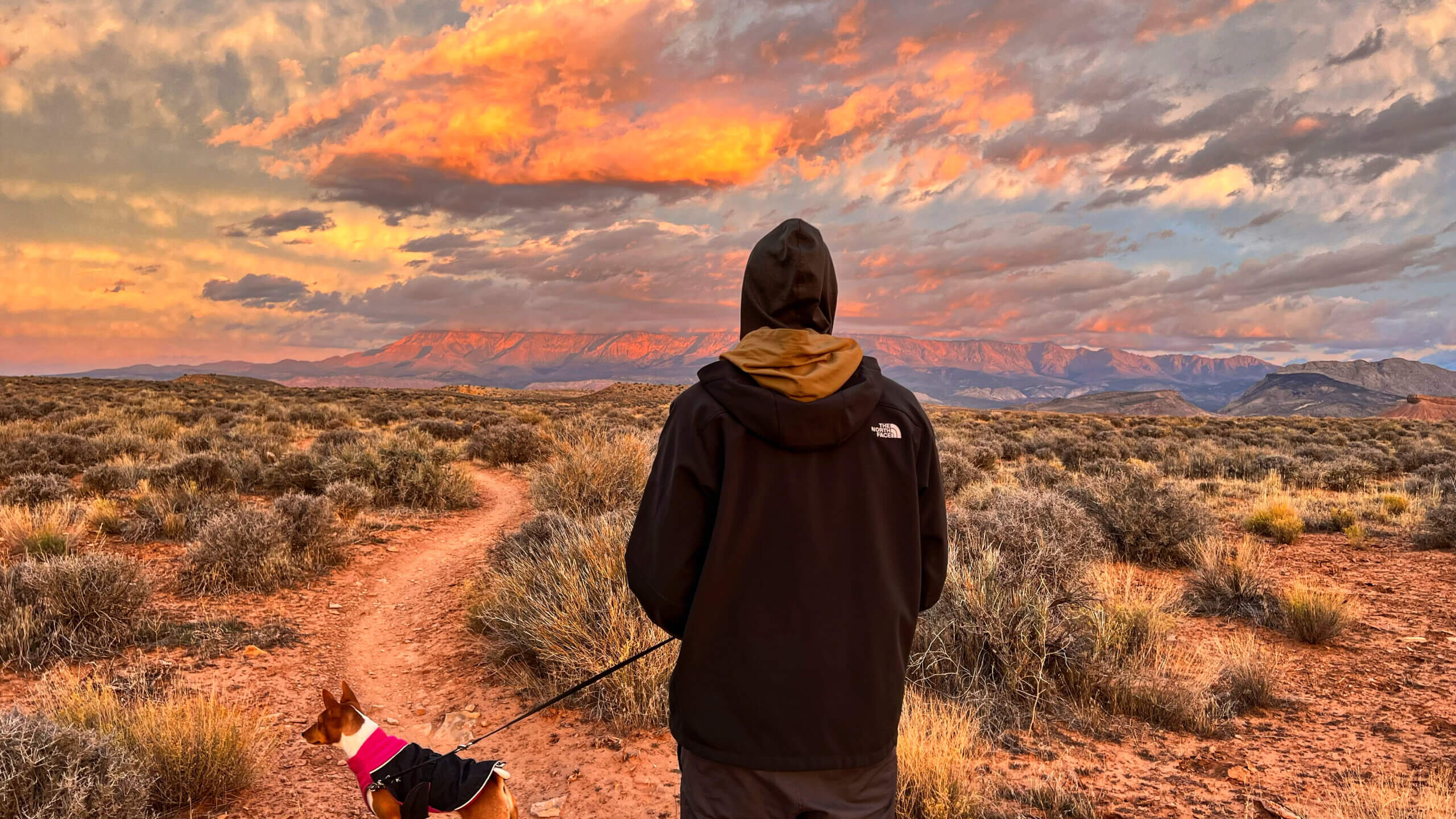
Top 10 Healthy Habits to Practice
There are several healthy habits that you can (and should) implement immediately to feel your best. Creating a daily routine can be difficult. It can be downright frustrating for many of us. But when you find your groove, nothing will feel better!
The importance of healthy habits
Did you know that over a third of your activities are actually not determined by you? It’s a habit. Your life today is the sum of your current habits.
Habits are the small decisions that you make every day and the actions that you take from them. We have outlined ten basic healthy habits that will help you live a healthier lifestyle. From improving healthy eating to physical health, these healthy habits stack up.
Living an RV lifestyle can certainly throw a wrench in your routine. Constant relocation and inconsistent daily schedules will keep you on your toes, that’s for sure. On top of that, we RVers tend to treat life like one big vacation. And there is nothing wrong with that! We are out here living our best life. The key to living a balanced RV lifestyle is to incorporate daily practices that improve your overall health and keep you on track with your goals.
Tried and true healthy habits
After coaching hundreds of clients across the country, we have some pretty good experience with helping others live their best lives. We have compiled our top list of the most impactful healthy habits. We personally practice these healthy habits ourselves, every single day, while living full-time in an RV.
1. Resistance train at least 3 times per week
At Healthy RV Living, we are all about resistance training. Skeletal muscle is critical for health, quality of life, and longevity. As a nation, we are severely under-muscled. This makes sense considering that as we age, we naturally lose muscle. If you are over the age of 20, you are likely losing muscle mass as you read this, unless you are actively weight training.
Not only does weight training build lean muscle mass, but it also increases bone density, protects against injuries, improves metabolism, aids with fat loss, increases flexibility and balance, improves posture, minimizes depression and anxiety, prevents cognitive decline, and improves confidence. With all of these benefits, why wouldn’t you start resistance training today?
It doesn’t take much to get you on the right track for building lean muscle. All it takes is a minimum of three training sessions per week, at least 30 minutes per session. We recommend using a wide variety of dumbbell weights or a high-quality set of loop-style resistance bands. Dumbbells and loop-style resistance bands are at the top of our list for essential RV fitness gear. Be sure to follow a program that targets all of your muscle groups for total body strength gains.
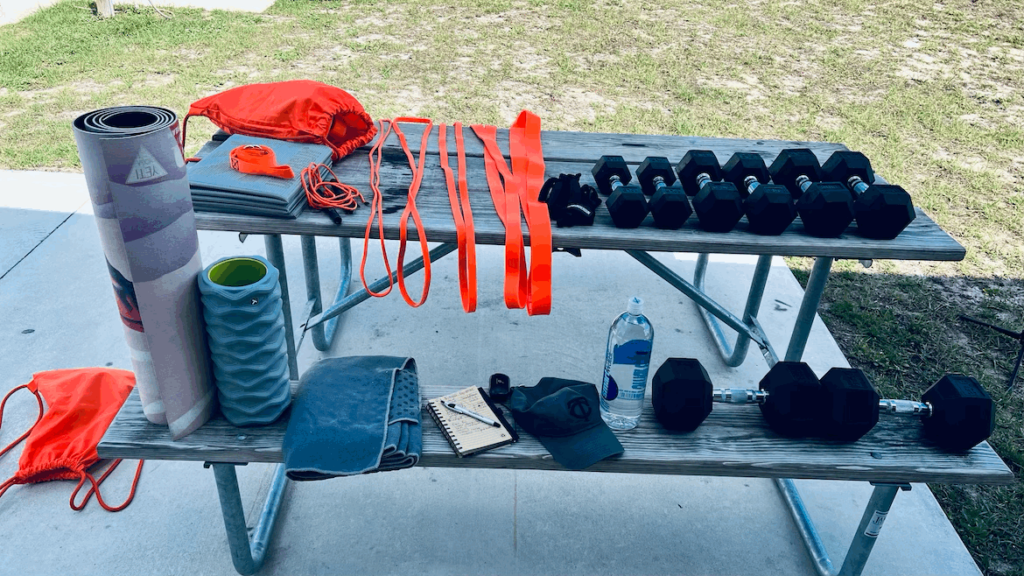
Resistance train at least 3 times per week
2. Get sunshine and fresh air every day
It can be easy to sit inside your RV all day long. This is especially true if you work from home (your RV). Before you know it, it’s dinner time, the sun is going down, and you want to cozy up on the couch. Staying cooped up all day is a bad habit that you can easily break.
Sunlight shares many of the same benefits of exercise. Both exercise and sunlight improve sleep, reduce stress, maintain strong bones, help keep weight gain away, fight depression, and can help you live a longer life.
Additionally, sunlight gives you that needed boost of vitamin D. Vitamin D is critical for your immune system. You can strengthen your immune system with consistent exposure to sunlight. Illness, infections, and some cancers will be less prone to take you down with consistent exposure to sunshine.
Fresh air is energizing and sharpens your mind. It cleans your lungs, helps your digestive system, can lower blood pressure, and strengthens your immune system.
Make sure you are properly prepared to spend time outside all year round. Invest in having a good rain jacket, umbrella, and plenty of cold-weather gear.
So how much time per day is needed to soak up these physical and emotional health benefits? You can reap the rewards with 5 to 30 minutes per day. If you’re ever feeling that afternoon slump, head outside for a dose of good health.
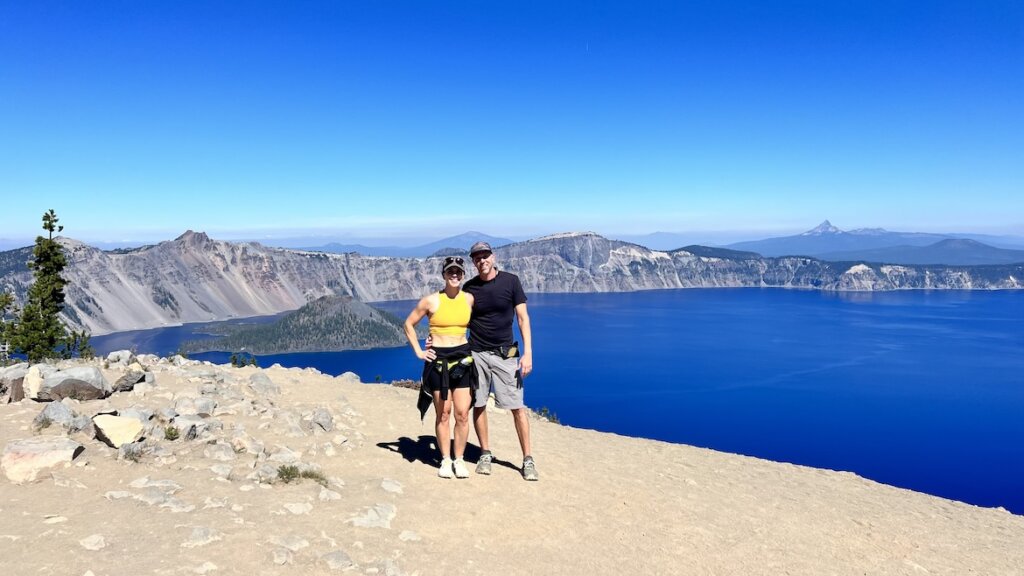
Soak up sunshine and fresh air
3. Aim to get 7,500 steps a day
Walking is highly underrated. We love it because it is low impact, highly accessible, and gets the body moving. The more steps you take, the more likely you are to get regular movement throughout the day. Humans are not meant to be sedentary. You may have even heard the saying, “Sitting is the new smoking”, and unfortunately it rings true. Excessive sitting has been linked to an increase in back pain, high blood pressure, heart attacks, and diabetes.
The average adult reportedly gets anywhere from 2,000-6,000 steps per day. Suppose you are nowhere near 7,500, target 1,000-2,000 above your current average and start there. Then, after a couple of weeks, ramp it up again. Continue to monitor and set goals for yourself. Of course, if you already are at or above 7,500, continue to do what you are doing, and don’t achieve less.
Getting steps in does take time though. If creating the time needed to get steps in is a problem, you may then want to look at other higher-intensity forms of exercise to get more bang for your buck (being the clock). And if you are really wanting to increase your metabolism or use walking for weight management, you may need to work up to 10,000-15,000 per day.
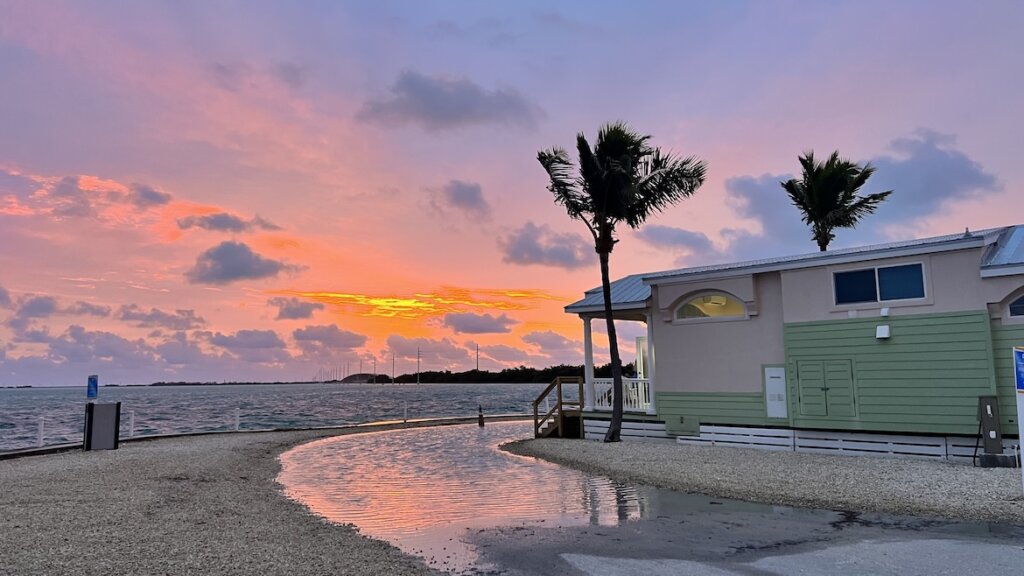
Start your mornings with a sunrise walk
4. Target 7-9 hours of sleep per night
Sleep deprivation is nothing to joke about. Poor sleep is directly linked to weight gain, weakened immunity, memory issues, mood changes, trouble concentrating, high blood pressure, risk of heart disease, low sex drive, and poor balance.
Consistently getting less than 7 hours of sleep per night can negatively affect your physical and mental health. You’ll feel groggy, tired, and just off.
There are several things that you can do to improve your sleep routine. For starters, try to stay as consistent as possible with your sleep schedule. Minimize electronics before bed. This might mean turning off the TV or shutting down your phone 30 minutes before bed. Try other activities such as reading a book, taking a shower, journaling, deep breathing, or stretching. Limit or avoid daytime naps, reduce alcohol intake, cut off caffeine after noon, and exercise regularly to help get better sleep.
If you’ve ever spent the night at a Walmart or Cracker Barrel, you’ve probably experienced the harsh security lights peeping into your RV. Take a look at the window coverings in your RV. Are they true blackout curtains? If not, consider upgrading to get full blackout coverage. An easier solution is getting an inexpensive eye mask. The eye masks work great to keep the light out. I personally own several of these and wear them every night!
5. Drink more water
Drinking water not only keeps you properly hydrated, but it provides a slew of other health benefits. It carries nutrients to cells, eliminates waste, protects joints and organs, and maintains body temperature.
Beverages like soft drinks and fruit juice can pack on calories, and refined sugar, as well as other artificial flavors. Ditch the sugary drinks and make water your go-to beverage. At the end of the day, water is the best choice for hydration.
The current recommended guidelines for water consumption are 90-120 ounces per day. We recommend drinking this throughout the day, starting the minute you wake up. “Twenty-four before your feet hit the floor” is a motto we use often. Before you even have your morning coffee, get a jump start on your daily water quota.
We have heard from some adults out there who just can’t stand the taste of water. Or lack thereof…If you find yourself in this category, try a few natural add-ins before reaching for artificial sweeteners or sugar-sweetened beverages. Fresh mint, lemon, lime wedges, and sliced cucumber are all healthy choices to enhance your H20.
Rather than wasting money, space, and energy lugging around single-use plastic bottles of water, invest in a long-term drinking solution. There are many filtration systems that you can use in the RV. Easy and affordable solutions are portable filters like the Brita or the Berkey. There are also more advanced in-line filtration systems, such as Clearsource.
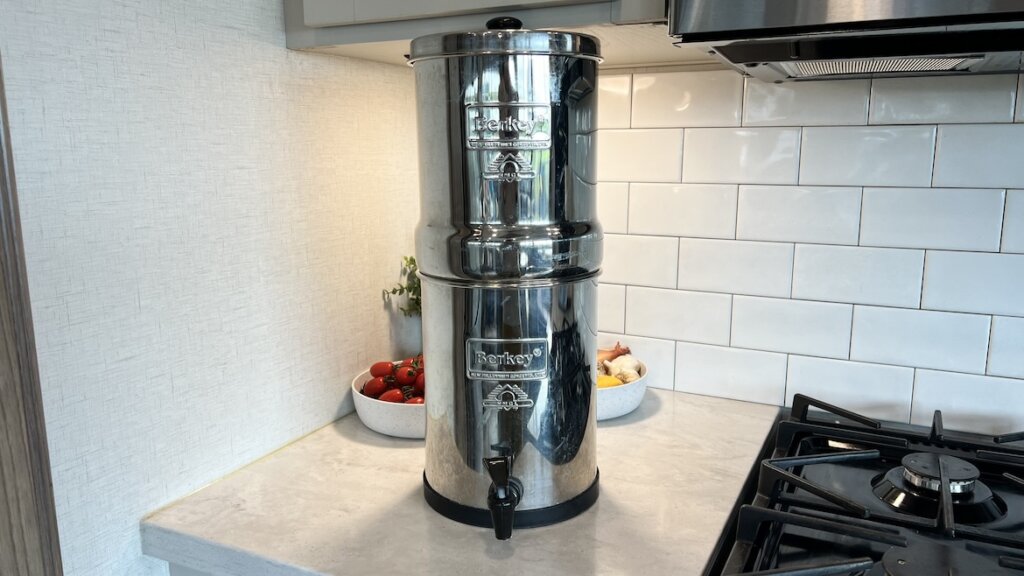
Find a water filtration system that works for your RV
6. Cook the majority of your food at home
Processed foods are the number one contributor to chronic diseases. Cooking at home is by far the most powerful way to control your food choices. This should come as great news to RVers since we always have our kitchen with us!
Processed food, fast food, and even sit-down restaurants are all culprits here. Sure, fast food may be known to have lesser quality ingredients and more fried food. However, sit-down restaurants are just as damaging. According to Time Magazine, “92% of meals from large-chain and local restaurants have more calories than is recommended for the average person”. Restaurant foods are often loaded with excess calories from trans fats and sugars.
Take control of your ingredients and portions by cooking at home. Food prep does take some extra time on the front end. But with continued practice, it will lead to a healthier life. There are various prepping approaches you can take. One of the most popular methods is the “Sunday ritual”. This involves taking a few hours on Sunday (or any day) and prepping for the entire week. Cook big batches of whole grains, starches, quality protein, and prepped fruits and vegetables.
Challenge yourself to reach for your home-cooked lunch rather than fast food on your lunch break. Recreate that frozen meal from scratch and connect with the fresh ingredients. And rather than trying to cut out all restaurant food cold turkey, try to gradually decrease your average number of meals out per week. Make this a fun experience and enjoy your time in the kitchen!
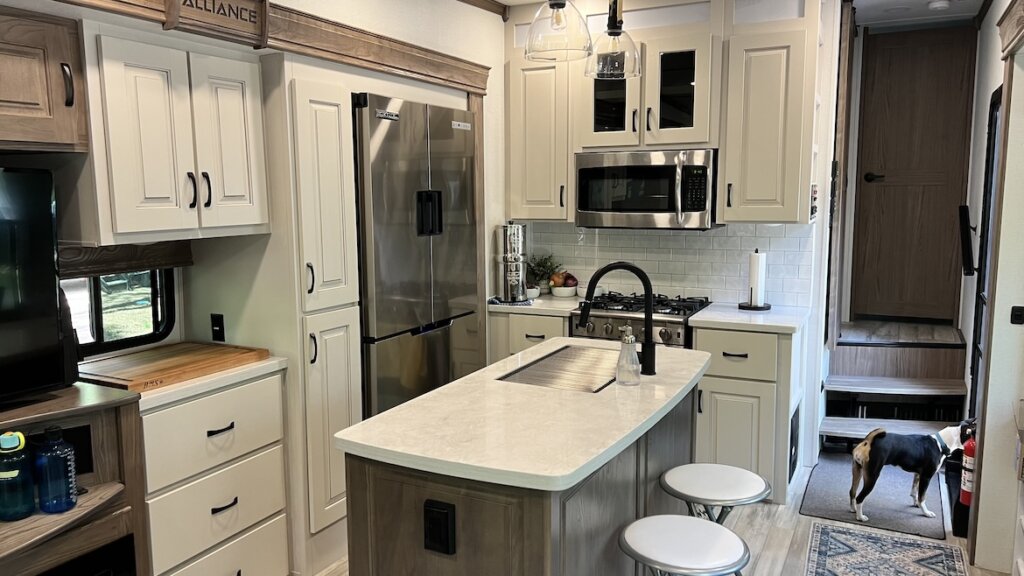
RV kitchen
7. Prioritize quality protein
Since we have gotten onto the subject of healthy foods, let’s talk about what you’re eating. Protein is highly under-eaten by many adults. And it plays a critical role in your healthy diet, as well as healthy aging.
Protein helps build and maintain skeletal muscle. Remember when we talked about lifting weights to help stay healthy and minimize risk factors? Here we go again with protein. There are two ways to help build and maintain muscle: 1) weight lifting and 2) dietary protein. Why not tackle both?
Protein is also important if you are trying to lose fat and get down to a healthy weight. It is hard work to be in a caloric deficit. Prioritizing protein will help keep you feeling full and satisfied. It will also protect your muscles and steer your body toward burning fat instead of muscle.
So what do we mean by “quality” protein? We are not talking about processed meats (cold cuts, hot dogs, protein bars, or “Beyond Burgers”). We are talking about fresh meats, fish, and eggs that have not been processed. These quality sources offer essential amino acids that are needed to promote muscle protein synthesis.
We like to keep our RV freezer stocked with quality proteins. We purchase our proteins online in bulk from a grass-fed and ethical source. Another cost-saving option to consider is purchasing in bulk from Costco or Sam’s Club. When we bring it home, break it all up and portion it into one-pound servings in Ziploc bags. Having pre-portioned servings in the freezer makes mealtime a breeze. You have less prep, less trash, and a properly portioned quantity to create meals with. Does your RV freezer need an overhaul?
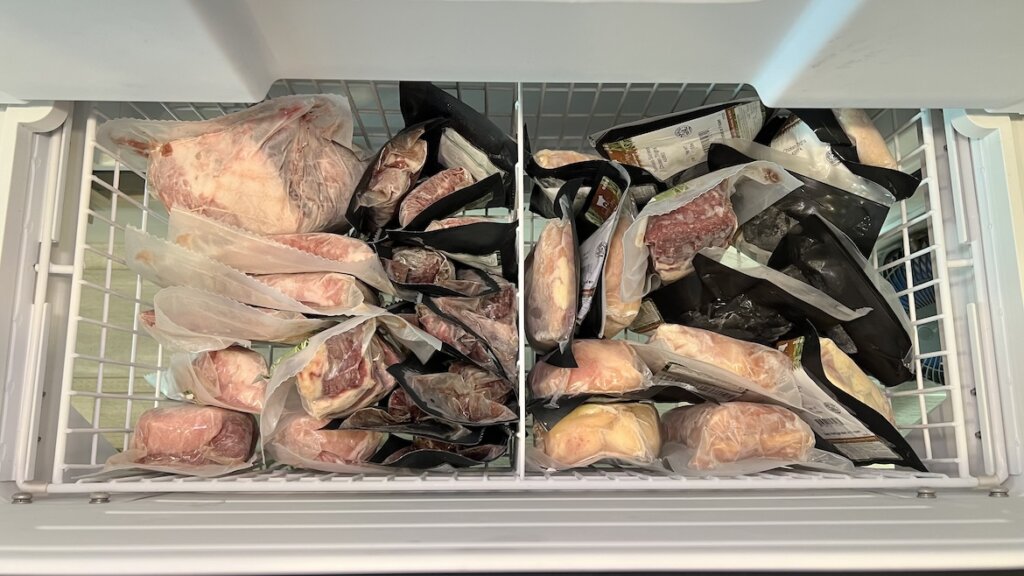
RV freezer stocked with quality protein
8. Pump up the vegetables
Vegetables should make up half of your plate at every meal. Including breakfast! Yes, we said it! Fruits and vegetables are so nutritious and are the answer to helping prevent chronic diseases. According to the Centers for Disease Control and Prevention, only 1 out of 10 adults get enough fruits or vegetables. This statistic is measured using a modest recommendation of 1 1/2-5 cups per day. We definitely don’t want you to fall into that statistic. So much that we will get a little crazy and up the recommendation, even more, to target 5-10+ cups per day.
First, pay attention to two different types of vegetables: fibrous vs. starchy. While both come loaded with vitamins and nutrients, some key differences exist. Fibrous veggies are packed with, you guessed it, fiber. They are also lower in calories. Some examples of fibrous vegetables are broccoli, leafy greens, green beans, brussel sprouts, asparagus, and tomatoes. Fiber is an excellent way to slow down the digestion of carbohydrates, help you feel fuller for longer, and aid with digestion.
Starchy vegetables are the familiar potatoes, corn, legumes, and beets. They have a higher starch and carbohydrate content and higher calories. A majority of your daily carbohydrates should come in the form of vegetables and fruits, rather than refined grains (crackers, bread, etc).
One of our favorite things to do as we travel the country is to visit local farmers’ markets. This is a great way to explore local areas and support local farmers. Spend a couple of hours out and about, being a tourist. Then bring home a haul of fresh ingredients, and create some magic in your RV kitchen!
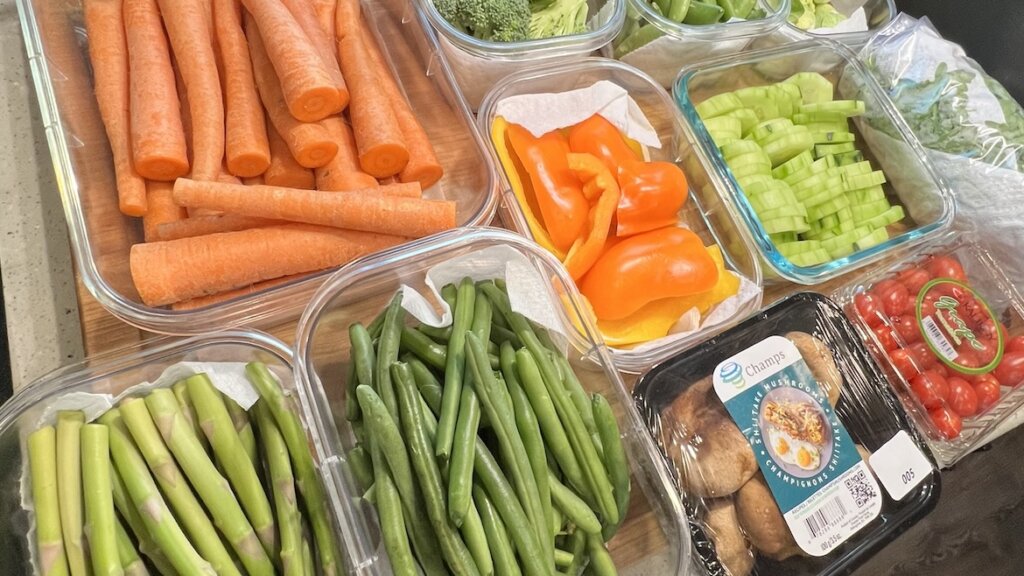
Prepped vegetables in an RV kitchen
9. Minimize ultra-processed foods
When it comes to healthy eating, ultra-processed foods are about as unhealthy foods as you can get. When you walk around a standard modern-day grocery store, over 75% of the “food” offerings are processed foods. From processed meats and meat alternatives to chips, crackers, cookies, breakfast cereals, condiments, frozen meals, meal-replacement bars, and more, it can be overwhelming.
Processed foods are mechanically engineered to taste amazing. The companies design these foods to leave you wanting more. As a result, you overeat, and afterward, you’re nutritionally unsatisfied. What a recipe for disaster!
Pay attention to what is on the labels of these foods. An insane amount of money is spent on marketing. They use terms on the packaging that make you “think” these foods are healthy when they are just processed junk food. Terms like: plant-based, heart-healthy, whole grain, vegan, keto, organic, gluten-free, fat-free, low calorie, the list goes on and on.
Next time you go grocery shopping, schedule some extra time to read labels. First, check the ingredients list. Ideally, the ingredients will be about five items or less. More importantly, you will be able to identify and recognize every item in that ingredient list. Second, get comfortable reading the nutrition info. Serving size, calories, carbohydrates, fat, fiber, sugar, and protein content are all important numbers to pay attention to.
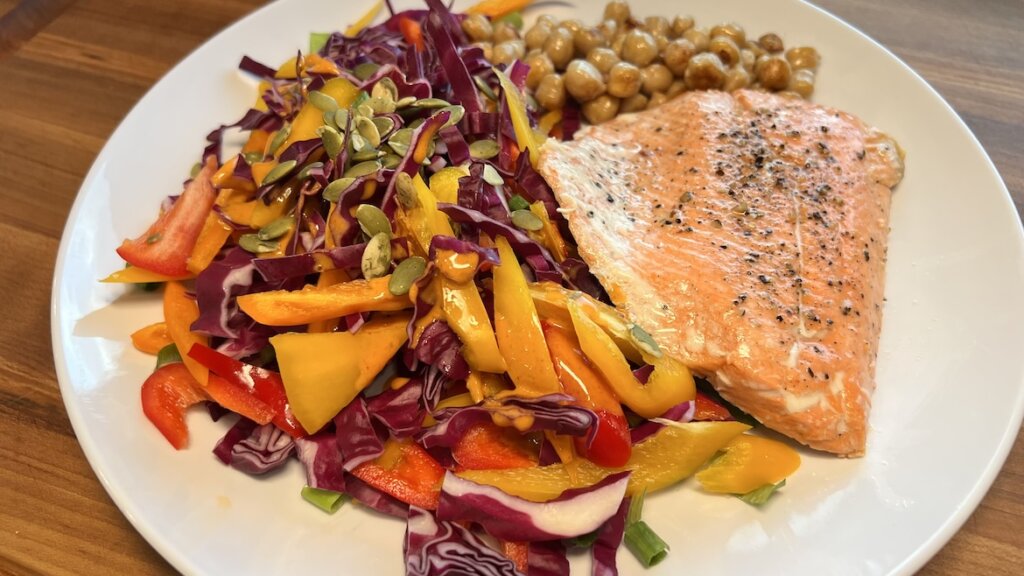
A meal cooked from scratch in an RV
10. Stay focused and consistent
People struggle with the “on and off” mentality when it comes to fitness and nutrition. I think this is a result of decades of fad diets, and the desire to get the most results with as minimal effort as possible. The fad diets and trends will promise fast results, and oftentimes times they come with drastic measures.
These fad diets and other highly marketed nutrition plans are often very restrictive. For example, cutting out entire food groups such as animal products, fruits, carbohydrates, and even vegetables is pretty typical in fad diets such as vegan, keto, and low-carb diets.
Meanwhile, many fancy (and expensive!) commercial nutrition plans are extremely low-calorie and require you to purchase their packaged food to stay on plan. If you are ever being pressured to purchase food in a package as a solution to good health, I encourage you to run!
The truth is, that healthy lifestyle habits take time and consistency. Don’t be discouraged when you don’t have a physical transformation in a short time. Be realistic with yourself on what your lifestyle is, day in and day out. I challenge you to practice these healthy habits for six months with 100% commitment. Stay focused and consistent. This is a sustainable approach to a true lifestyle change.
Time to collect significant health benefits
Hopefully, we have inspired you to incorporate these healthy habits today. Maybe you’re already doing a few of them, or better yet even a majority of them. If there are even just a couple more that you can add to your routine, it’s worth the effort.
Sometimes picking just one thing at a time to add in can be a gentle way to progress. If you tack on too much at once you may find yourself overwhelmed. Pick one habit that you feel most confident that you can consistently perform. Master that habit for a couple of weeks. Once that feels like “normal”, then add in another.
Breaking your goals up into small, achievable steps is extremely effective. Taking slow continuous steps will get you to your end goal much quicker than taking big jumps, then jumping backward. Cheers to healthy habits!
If you are interested in getting more help and accountability on an individual level, check out our online coaching options.

Related Posts
Travel trailers offer a unique blend of comfort and adventure, allowing enthusiasts to explore the great outdoors while still enjoying the comforts of home. Since they are typically smaller and lighter than their big brother 5th wheel, many travel trailer owners go off the beaten path or into National Parks and Forests where the roads […]
The obvious answer is they both start with the letter W, but if you own a 5th wheel trailer that is equipped with a washer and dryer, then you know the answer is they both cause my 5th wheel to shake, rock and roll. 5th wheel trailers are typically: • Taller — which means their center of […]
That’s a question we are increasingly hearing from travel trailer and 5th wheel owners. Before we answer that question, some of you may be wondering what is a crossmember and why would I need one?What is a frame crossmember? When a trailer frame is built, each OEM will specify the number and location of frame […]
CATEGORIES
RECENT POSTS
It looks like your installation might require some modifications.
Please contact our parts department to discuss options that may work for you.
Sign Up
MORryde SUPPORT CENTER
Contact MORryde with form below
Product News: Sign up for new product updates
MORryde
QUICK LINKS
MORryde Plant Contact Information
Plants 5, 6, 7, & 8 – Sterling
Corporate Location
Service Center – Plant 5
1966 Sterling Avenue
Elkhart, Indiana 46516

